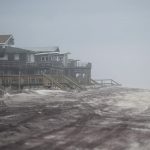As temperatures rise to unseasonably warm levels across Texas this week, its citizens are being asked to use less energy on basics like cooking and washing clothes to ease strain on the state’s power grid that is struggling to generate enough electricity to cope with the high temperatures.
The move triggers memories for many Texans of the cold snap in the winter that incapacitated much of the state’s power infrastructure and raises fears that Texas – and other US states – are not prepared to deal with the extreme weather events that come with the global climate crisis.
The authority running the Texas power grid has asked Texans to set thermostats to 78 degrees or higher, turn off lights and pool pumps and avoid using large appliances such as ovens, washing machines and dryers.
This is the second time that the Electric Reliability Council of Texas (Ercot) has issued such a call for conservation since the winter storms in February left more than 4.8m homes and businesses without electricity for days. The crisis was blamed for more than 100 deaths and $130bn in costs.
In addition to plant outages, demand is high this week as cities across Texas expect temperatures in the 90s. The state broke its June electricity demand record on Monday.
Summer hasn’t even officially begun, and the early calls for conservation raise questions over what will happen in the coming months and years as the global temperature continues to rise.
“We’re heading into a future climate that is likely to have more extreme droughts and more powerful hurricanes, which put their own strain on the system,” said Dan Cohan, a civil engineering professor at Rice University. “This week we saw that the Texas power grid barely even prepared for weather that is hot for June, but nowhere near how hot it can get in July and August.”
Cohan says that Ercot has not been transparent about which coal and gas plants are down and helping cause the strain on the grid, and why – it could be for maintenance, or repairs from February’s knockout blows, or preparing for potential summer demand.
“Ercot has really been leaving us in the dark as to which coal and gas power plants are down, and why,” he said. “They offered a belated acknowledgment that there are more than twice as many power plants down as they expected but no real clarity on why it’s happening. A lot of us are left guessing.”
The grid is only prepared to handle one crisis at a time, but often tissues overlap – for example, when it’s very hot, often winds don’t blow as they typically would, or a spike in demand while power plants are offline.
“We need to be prepared for it, not just because of random chance, but because these challenges can be correlated,” said Cohan. “Often when we have extreme weather events they can stretch both supply and demand at the same time.”
Solar generation is growing fast in Texas, and that has saved the lights this week.
“We could be in the midst of a two-year growth spurt that is faster than any state has ever experienced in solar generation,” said Cohan. “We have over five times as much solar as we had a few years ago and that made the difference in having these afternoons when we’ve had calls for conservation. There likely would have been rolling blackouts if we didn’t have solar farms online.”
Still, much more needs to be done: the grid needs to be weatherized, transmission from windy and sunny areas needs to be extended to fast-growing cities, and Texas’s grid needs to be integrated into other states, he says.
In this year’s Texas legislative session, lawmakers passed a series of reforms aimed at safeguarding the state against blackouts. At a signing ceremony last week, the Texas governor, Greg Abbott, said that “everything that needed to be done was done to fix the power grid in Texas”.
Kyri Baker, a building systems engineer at the University of Colorado Boulder who studies power grids, said there needed to be better systems of coaxing consumers to use less energy, something that’s known as demand response.
“It’s 2021 and we’re requesting demand response over Twitter,” she says. “We can’t just ask people to not use their oven, because there’s no guarantee that people will participate.”
Many people don’t know which devices in their homes suck up the most power; it’s typically not lights, but instead heating and cooling systems and water heaters. She says that paying people to install smart meters and smart thermostats would go a long way to allow utilities to enact granular power cuts, rather than cutting power to entire swaths of a city.
She adds that connecting Texas to other states seems like an easy solution, but it’s no panacea: when there are large-scale heatwaves that drive up demand, they hit other states too. “It’s more complicated than just putting up more power lines.”

Average Rating